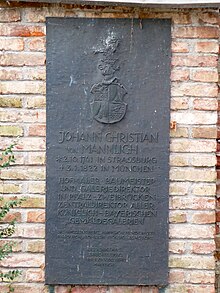Johann Christian von Mannlich


Johann Christian von Mannlich (until 1808: Johann Christian Mannlich ; born October 2, 1741 in Strasbourg ; † January 3, 1822 in Munich ) was a German painter and architect .
life and work
Mannlich was born during his parents' stay in Strasbourg and raised in Zweibrücken . He learned the art of painting from his father Conrad Mannlich (1700–1758), who was court painter under Christian IV of Pfalz-Zweibrücken . He received his further education at the art academy in Mannheim and in Paris, where he met numerous artists of the French Rococo , who also influenced his early style. Mannlich became court painter under Christian IV of Pfalz-Zweibrücken, general building director under Karl II. August von Pfalz-Zweibrücken and central gallery director under King Maximilian I Joseph of Bavaria .
Under Charles II August he put an important collection of paintings on it, which was housed in Karlsberg Castle near Homburg . Before the castle was destroyed on July 28, 1793 by French revolutionary troops , Mannlich saved the collection of paintings, library, weapons collection, furniture and paneling, among other things . The picture gallery finally came to Munich via Mannheim and formed the basis of the Alte Pinakothek . Mannlich, who followed his princes to Mannheim and Munich, turned to lithography in Munich .
Mannlich was general building director for the Duke of Zweibrücken and chief architect on the Karlsberg. His autobiography , written in French, is one of the most important sources about the Karlsberg and about the last princes of Pfalz-Zweibrücken . Nothing of the buildings built according to his designs in the style of classicism remained.
The Bavarian officer and forester Carl von Mannlich (1787-1832) from Zweibrücken was his son.

tomb
The tomb of Johann Christian von Mannlich is on the old southern cemetery in Munich (Old Arkadenplatz 10 at cemetery 25) location . The grave was destroyed in World War II. The bust of Mannlich from the original grave and a bronze sarcophagus with a life-size reclining figure, set up for Mannlich's daughter Caroline, who ran the household for her father as an unmarried daughter, have been preserved. Johann Baptist Stiglmaier , with the support of Christian Daniel Rauch , made a bronze sarcophagus in front of the original tomb for Mannlich's daughter Caroline von Mannlich (February 9, 1784 - July 27, 1830). The work is one of the most important monuments of the Old Southern Cemetery and was even mentioned in tourist guides about Munich. The bust and sarcophagus are now in the Munich City Museum. A memorial plaque erected in 1972 to mark the 150th year of his death commemorates Johann Christian von Mannlich at the original grave site.
Appreciation
In 1986 a Mannlich memorial was set up in Mannlich's house in Zweibrücken , the "Mannlichhaus" (Herzogstrasse 8). Some of his paintings are exhibited in the Edelhaus in Schwarzenacker . In Homburg there is a grammar school named after him, the Christian von Mannlich grammar school .
The Association of Palatinate Friends has been awarding the Johann Christian von Mannlich Prize since 1974 to preferably young Palatinate artists in Bavaria (painters, sculptors, graphic artists, photographers).
Works
- Histoire de ma vie . Ed .: Karl-Heinz Bender and Hermann Kleber, 2 volumes, Trier 1989–1993 ISBN 3-87760-700-4
- Rococo and Revolution (memoirs), Mittler Verlag, Berlin, 1913, 568 pages with plates ( digitized )
literature
- Hyacinth Holland : Mannlich, Johann Christian von . In: Allgemeine Deutsche Biographie (ADB). Volume 20, Duncker & Humblot, Leipzig 1884, pp. 207-209.
- Berthold Roland: Mannlich, Johann Christian von. In: New German Biography (NDB). Volume 16, Duncker & Humblot, Berlin 1990, ISBN 3-428-00197-4 , pp. 74 f. ( Digitized version ).
- Karl-Theodor Stahl: Conrad Mannlich 1700–1758. Johann Christian von Mannlich 1741–1822. Newly discovered and rediscovered works 1978–1988 . Kunsthandlung Karl-Theodor Stahl, Mannheim 1989
Individual evidence
- ↑ Claudia Denk, John Ziesemer: Art and Memoria - The Old Southern Cemetery in Munich (2014), pp. 271 ff, ISBN 978-3-422-07227-5
- ^ Announcement 2015 on the website de Bundes der Pfalzfreunde. Retrieved September 17, 2015.
Web links
- Literature by and about Johann Christian von Mannlich in the catalog of the German National Library
- Literature on Johann Christian von Mannlich in the Saarland Bibliography
- Zweibrücken Mannlichhaus
| personal data | |
|---|---|
| SURNAME | Mannlich, Johann Christian von |
| ALTERNATIVE NAMES | Mannlich, Johann Christian |
| BRIEF DESCRIPTION | German court painter and general building director |
| DATE OF BIRTH | October 2, 1741 |
| PLACE OF BIRTH | Strasbourg |
| DATE OF DEATH | January 3, 1822 |
| Place of death | Munich |